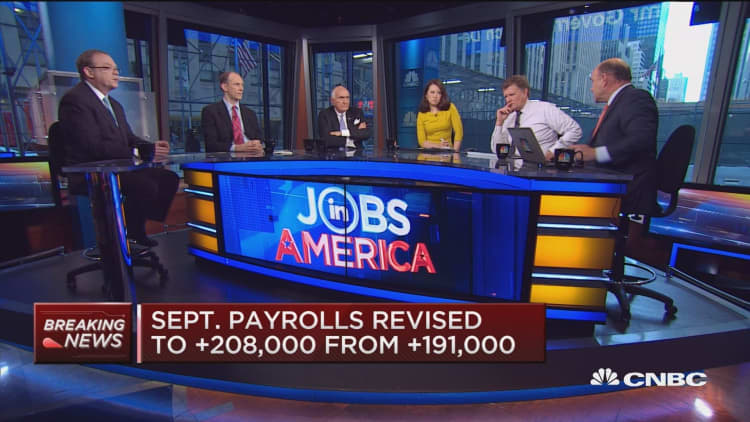November's stunning dip to a 4.6 percent unemployment rate, and the fact the economy is still adding jobs at a healthy clip, should give the Fed the green light to hike interest rates when it meets later this month.
Unemployment was at its lowest since August 2007, and job gains continued to be strong in November, coming in at 178,000, in line with this year's average of 180,000. However, wage growth backtracked, with a surprise 0.1 percent drop in average hourly wages, compared with expectations of a 0.2 percent gain.
"Average hourly earnings is disappointing. The drop in the unemployment rate — this is the best of the cycle. You had a huge drop in the level of unemployment and an increase in employment. They're saying things are improving," said Ward McCarthy, chief financial economist at Jefferies.
Unemployment had been 4.9 percent in October and was expected to stay the same for November. The report also showed that the labor participation rate declined by 0.1 percent to 62.7 percent, signaling fewer Americans in the workforce and a factor behind the fall in the unemployment rate.

Average hourly wages had increased by 0.4 percent in October, a pace that had it continued would signal wage growth heading toward 5 percent annually. Wages had been growing at about 2.5 percent annually. The November 0.1 percent decline was the lowest since December 2014.
After the report, the Dow Jones industrial average was down slightly and bond yields fell. On Thursday, yields rose sharply ahead of the number as speculation swirled that the employment report could be very strong and show wage pressures, which would be a sign the Fed may have to hike more than expected at subsequent meetings next year. The slightly disappointing report brought in buyers for Treasurys, as did concerns about this Sunday's Italian referendum.
"It wasn't a slam dunk number by any means. The wages (number) is the most important, but it's important to know it came off a surge last month," said Diane Swonk, CEO of DS Economics. "It's a hiccup in wages, but not enough to stop the Fed."
There was also a decline in a broader measure of unemployment from 9.5 percent to 9.3 percent, now the lowest since August 2008. The U6 rate captures a wider group, including those who work part time but would like full-time jobs, as well as people who have stopped looking for work.
"The thing that's going to be taken away from this a few days from now is going to be the drop in the unemployment rate to 4.6 percent. Even the U6 number fell. It was a broad-based drop in the unemployment rate," said James Paulsen, chief investment strategist at Wells Capital Management. "At the end of the day, we made another notch down in the unemployment rate and ultimately that's going to be leading to more pressure on wages and costs. With wages down today, that may not be the story today, but it will be in a week. A huge drop in unemployment, … I think that's going to be the part that sticks."
A big focus for markets and economists has been wage growth, which has lagged with stubbornly low inflation. But there are signs that both are picking up, and the November number is going against the trend, said Swonk.
"You've got to take it in context. Last month was an extraordinary jump," she said. "I'm not happy with it, … but at the end of the day the wage number was really strong in October, so you take a moving average and that's what the Fed will do." The Fed rate announcement is expected after its meeting on Dec. 14.
The Commerce Department on Wednesday reported that personal income rose in October by 0.6 percent, the fastest growth rate since April and up from 0.4 percent in September.


